|
Report from the Ladonia Mountain Trophy 14 th July 2007
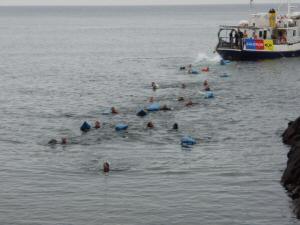 The path descended steeply through the beech forest, the moist air thick with that earthy just-rained smell, and as we ran rounded the last bend, the trees gave way to the rocky coast and with it an amazing sculpture. Made out of, what looked to be railway sleepers, flotsam and jetsam, the structure (think ‘The Wicker Man’) is called the Nimis and a source of much attention and controversy. It has, in fact, attracted so much legal attention from the conservation and legal authorities that it led to the creation of the proud independent state of Ladonia solely to escape the Swedish legal system. The path descended steeply through the beech forest, the moist air thick with that earthy just-rained smell, and as we ran rounded the last bend, the trees gave way to the rocky coast and with it an amazing sculpture. Made out of, what looked to be railway sleepers, flotsam and jetsam, the structure (think ‘The Wicker Man’) is called the Nimis and a source of much attention and controversy. It has, in fact, attracted so much legal attention from the conservation and legal authorities that it led to the creation of the proud independent state of Ladonia solely to escape the Swedish legal system.
Stephen and I were in Sweden to compete in the Ladonia Mountain Trophy, a race that takes place on a small peninsular known as Kullaberg (killer mountain), of which Ladonia is a small part. It is held annually and is billed as ‘ Sweden’s toughest one day race’.
We were there at the invite of Per Stojen, the race organiser, who has completed, along with many of the marshals and other competitors, many of the Mountain Marathons in Britain.
The base for the race was one of the comfortable, local camp sites equipped with many of the luxuries, much more than what us scuzzy English fell runners were used to.
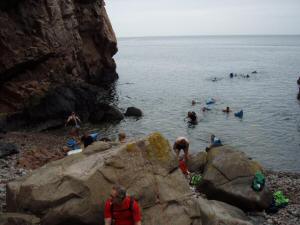 On the Saturday morning, the Elite Competitors were transported in two batches by boat to a tiny cove on the end of the headland. The exact location remained a secret until we actually started, though, in the main, the race doesn’t vary much from year to year. On the Saturday morning, the Elite Competitors were transported in two batches by boat to a tiny cove on the end of the headland. The exact location remained a secret until we actually started, though, in the main, the race doesn’t vary much from year to year.
We had a final briefing on the back of the boat, and there was one mad rush to jump in as early as possible (the boat drifts out to sea as people jump you see). I threw the plastic bag containing our kit and jumped in after it. After taking what seemed like an age to surface, I looked up to see Steve in front. After I’d jumped he’d dibbed and then executed a perfect racing drive to surface in front. We swam for 80m (it wasn’t going to be the last visit to the sea), collected the first maps of the day and scrambled up the steep gully to the lighthouse and the first checkpoint of 41!
The first part of the course had the more technical navigation and zig-zagged over the flatter central section of the Kullaberg taking in forest, hills and some nasty scrubland. The navigation shouldn’t have been too difficult as long as you stayed on the paths and tracks, because much of the land was covered in thick scrub, the dreaded ‘fight forest’ as indictated by dark green on orienteering maps and beloved by orienteers (not!). Running from control 3 to 4 we had to pick up an indistinct path on the left and then drop into a small valley to find the control on the edge of a marsh. It was at this point, however, that I decided to follow someone else who looked to have local knowledge of the area. Big mistake! We took several minutes to relocate and punch the control before carrying on. The rest of the course passed by in a blur of line features, leafy open running and nice paths.
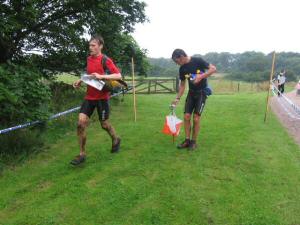 We got to the map change some way behind the leaders and whilst Steve sorted the water I marked up the second map. This, the mountain section, consisted of some steep descents to the coast with the navigation being somewhat easier, unfortunately, though, the map being used wasn’t quite as accurate. So, with a bit of time lost getting used to the new scale, we ploughed on, enjoying the running, and hoping we would make up some time on this section as it was going to suit us more. We got to the map change some way behind the leaders and whilst Steve sorted the water I marked up the second map. This, the mountain section, consisted of some steep descents to the coast with the navigation being somewhat easier, unfortunately, though, the map being used wasn’t quite as accurate. So, with a bit of time lost getting used to the new scale, we ploughed on, enjoying the running, and hoping we would make up some time on this section as it was going to suit us more.
One hour later we arrived at the second sea section, with the control attached to a buoy (Steve executing another perfect dive off the pier). Patrons of the nearby café had some free entertainment to while away the lunchtime on the beautiful coastline by the, now rough, sea.
Most of the remaining controls were situated on or near to the coast and yet again the hardest part was avoiding the scrub. Just after the second water station, next to the road, we again dropped down to the sea and had to swim to an Island where the next control was situated. Then, after some interesting but quick scrambling around the coast to the old lighthouse (2 minutes quicker than the inland route), we headed back around the north coast to the final few controls and the ‘sprint’ to the finish.
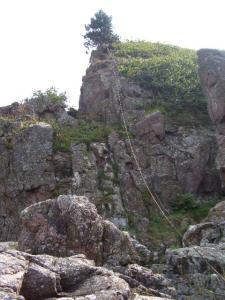 At the start Per, the race director, had warned us to expect a surprise and it was at yet another gorgeous beach control, that it the surprise presented itself. One of the buttresses was equipped with top ropes and it was this that Steve, even though I was the climber, launched up. A few more easy, but steep, controls and we raced down into Molle habour to finish. At the start Per, the race director, had warned us to expect a surprise and it was at yet another gorgeous beach control, that it the surprise presented itself. One of the buttresses was equipped with top ropes and it was this that Steve, even though I was the climber, launched up. A few more easy, but steep, controls and we raced down into Molle habour to finish.
Overall it is a hard race with much steep terrain and moderately challenging navigation in a very beautiful area of southern Sweden. The Swedish we met were fantastic, being both warm and friendly. The guys we met and often come over to the UK to race were very keen to have a few more English runners over to race in Sweden.
Information
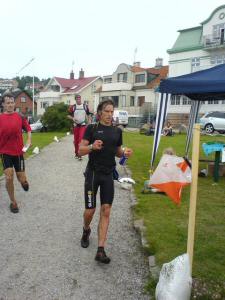 The nearest airport is Copenhagen and it takes about one and a half hours to travel to Hellsingborg (the nearest large town) by train and costs about £15 single. From here it’s another half an hour to the event centre. Most of the competitors stay for the post-race barbeque at the camp site ( Möllehässle campground) on the Saturday night. The nearest airport is Copenhagen and it takes about one and a half hours to travel to Hellsingborg (the nearest large town) by train and costs about £15 single. From here it’s another half an hour to the event centre. Most of the competitors stay for the post-race barbeque at the camp site ( Möllehässle campground) on the Saturday night.
The race
Elit |
22-25 km on the line, and approx 1600-2100 ascending meters |
Lång |
15-18 km on the line, and approx 1000-1500 ascending meters |
LMT is a one day competition where you can compete alone, in pairs or threes.
Some interesting facts about the country of Ladonia:
- In 1996 the country proclaimed its independance from Sweden.
- No one livies in Ladonia, all of its citizens are nomads.
- The currency is Örtug. Taxes are to be payed in Ladonia but not with money. Citizens pay by giving away a part of their creativity.
- There are two national anthem is executed when a stone is thrown into the water.
- It covers 1 square km in area.
- There is a postal service but senders have to deliver their own letters after they have been franked.
Jonathan Aylward
Webmaster Note: Jonathan failed to mention in his report that he and Stephen Bottomley won the Elite course!
|

